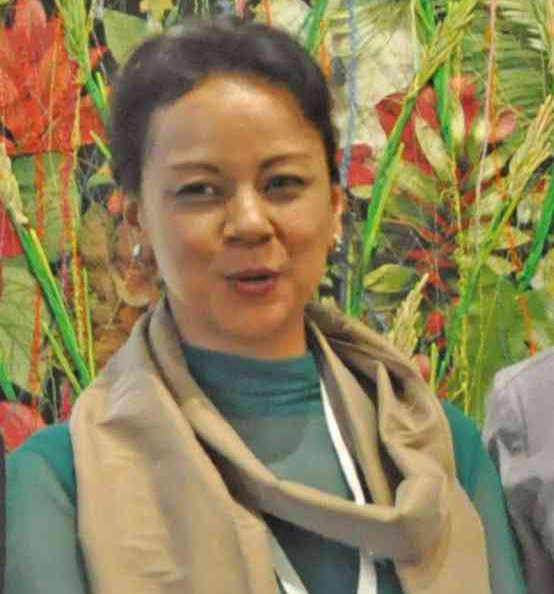For more than 10 years now, Roberta Dans has been performing the pioneering service of helping Filipino and Southeast Asian visual artists make it abroad, specifically in Singapore. Her love and passion for the arts have a strong and intense foundation—no less than the heart, hearth and home of her mother, the acclaimed senior artist and art educator, Araceli Limcaco Dans.
It is a testament to the success of Dans’ earnest and visionary efforts that more than 20 of the artists she has helped discover and mentor are now setting sales records and eliciting interest and acclaim abroad.
It all began in 2005, when Roberta took a deep breath and opened the Artesan Gallery + Studio in Singapore—“to create a robust and energetic space where both artists and enthusiasts could converge and exchange ideas.”
Roberta’s philosophy for Artesan has always been pro-artist. Given her family’s artistic back story, it was easy for her to empathize with them and their aspirations—and, more importantly, to use her curatorial skills to provide the exhibits and other showcases they urgently needed, to attract and command the attention they deserved.
In addition to exhibits at Artesan, Dans later initiated artist residency programs around the region. One of the first to benefit from the residency experience was Ronald Ventura, to date the most celebrated of Roberta’s featured artists.
Critics and reviewers have been keenly struck by his unique combination of prodigious painterly skills and potent themes. The excitement over Ventura’s visionary and edgy works has prompted the steep escalation of the financial value of his canvases and “toys,” amazing the art world and adding to the cachet of other Filipino artists’work, as well.
Aside from aspiring artists, Dans has also been providing international exposure for more established painters and sculptors, like Antipas Delotavo. A member of the Kaisahan group of social realist artists, his “Dire Patterns” exhibit at the NUS Museum fascinated viewers with its unique fusion of seemingly sophisticated images with the “direness” of its emblematic warnings about dangerous developments in the areas of ecological disasters, colonialism and gross commercialization.
Renato Habulan, also of the Kaisahan group, was similarly showcased by Artesan, and viewers were particularly struck by his canvases’ depiction of “disparity and absurdity between religious, political and social ethics.”
Childlike view
Contrastingly, Renato’s son, Guerrero, has “a sense of humor that purposely lightens the load off the sordid truth.” He struck Dans with his childlike view of art and life—which, quite significantly, doesn’t blunt the edge and bite of his insights into current society’s fatal dissonances.
For its part, Marina Cruz’s exhibit at Artesan, “Lost Finds,” disarmed viewers with its “ordinary” objects, images and memories from her own life.
Another Artesan-exhibited painter with a unique vision is Victor Balanon, whose stark pen-and-ink images conjure up a surreally hypnotic, postmodern world, full of strangely cold foreboding.
For his part, Jon Jaylo compels attention with his seemingly ordinary and yet “eventually” surreal elaborations on reality, like his pen-and-ink sketch of a turtle that has opted to take the next “logical” step—and morphed into a house!
Another original artist, RaffyNapay, chooses to work not with brush and paint, but with needle and all types and sizes of threads and fabrics! He creates neo-tapestries that conjure up poetic visions of clouds or lush forests. Recently, Roberta facilitated a three-month residency program for him at a New York museum in 2016.
Disarmed by the artist’s unique approach and purity of vision, Dans turns personal and candidly shares, “The exhausting experiences in this trade are sometimes exasperating. But, with artists like Napay, when you witness their works in the making, you recall the true reason you are doing this: for love of art, and the virtuosity of human creativity! The experience also reminded me why I founded Artesan—to work with and nurture artists of exceptional talent.”
Consistent
What is consistent is the fact that the artists are all gifted—but, each has been very wisely given the freedom to be true to his or her style and vision.
This evinces a great deal of confidence and trust on Dans’ part that talent is unique—and should be allowed to develop on its own terms.
To be sure, as Dans shares in her notes on Napay’s work, that essential confidence and trust weren’t easily achieved. But, after more than a decade of “exhausting and exasperating ups and downs,” the right lessons have been learned.
More to the point, Artesan has won the respect and admiration of the Asian art community, as indicated by the eagerness of institutions like the National Arts Council of Singapore to collaborate with it on major initiatives and showcases.
Roberta looks back and shares, “It’s sometimes been an uphill struggle, but the success and esteem that our artists are savoring make it all worth it!”
It’s also gratifying to realize that so many people in Asian art circles have faith in her unerring eye for talent—as evinced by the fact that the choice of Southeast Asian representation to the prestigious Florence Bienale has been entrusted to a selection committee of one—herself!
It must have taken a lot to attain and deserve that enviable position of trust and reputation for objective judgement, but Dans has done precisely that, so the psychic rewards are fully hers to savor.
How can other art lovers help Filipino artists come into their own internationally? Dans shares, “Access to more funding and sponsorships would help a lot. And a change in attitude in how artists should be regarded—as professionals. Let them evolve on their own terms, and we’ll all be the better for it!”


